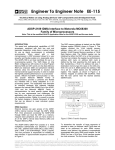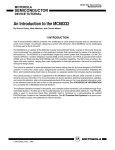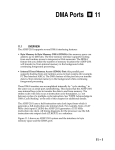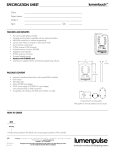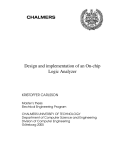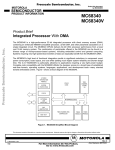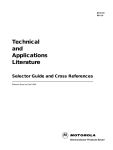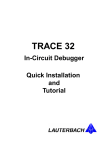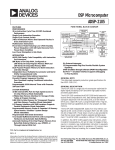Download ADSP-2181 IDMA Interface to Motorola MC68300
Transcript
a
ONE TECHNOLOGY WAY
• P.O.
AN-415
APPLICATION NOTE
BOX 9106
• NORWOOD,
MASSACHUSETTS 02062-9106
• 617/329-4700
ADSP-2181 IDMA Interface to Motorola MC68300
Family of Microprocessors
INTRODUCTION
The speed and mathematical capabilities of DSP processors,
combined with their low cost and expanded integration, make
them a natural choice for use as signal co-processors in
embedded environments. When paired with a host
microprocessor, a DSP processor allows for a very powerful
and flexible system at a reasonable price.
The ADSP-2181 is an ideal candidate for use in a coprocessing system. The 32K words of on-chip SRAM and
extensive DMA and peripheral interface features allow the
ADSP-2181 to function with minimal external support circuitry.
In order to realize the highest possible performance in a coprocessor system, efficient host-DSP communication is vital.
The popular Motorola M68300 Family of microcontrollers
provides a powerful and flexible bus interface that is easily
adaptable to a co-processing system.
This application note describes an example hardware and
software interface between the Internal DMA (IDMA) Port of
the ADSP-2181 and the Motorola M68300 Family of
microcontrollers. As each specific system design has its own
requirements and challenges, this application note does not
presume to provide the only possible solution. Rather it is
meant to provide the system designer a flexible framework of
ideas that can be tailored to meet individual system
requirements.
The ADSP-2181’s IDMA Port consists of a 16-bit multiplexed
address/data bus (IAD16:0), a select line (IS), address latch
enable (ALE), read (IRD), write (IWR), and acknowledge (IACK)
signals. The host processor is responsible for initiating all data
transfers. A typical transfer sequence is shown in Figure 1.
The DSP memory address is loaded into the IDMA Address
register (IDMAA) shown in Figure 2. This register contains the
14-bit internal memory address, along with a bit to specify the
type of transfer: 24-bit Program Memory opcodes, or 16-bit
Data Memory data. The IDMAA register can be initialized by
either the DSP or by a host processor. The host can initialize
this register by performing an address latch cycle. An address
latch cycle is defined by the host asserting the ALE signal, and
then transferring a 15-bit (14 address bits plus 1 destination
memory type bit) value on the IAD pins. To streamline the
Host Starts IDMA Transfer
Host checks IACK control line
to see if the DSP is busy.
Host uses IS and IAL control lines to latch
the DMA starting address (IDMAA) and
PM/DM selection into the DSP's IDMA
Control Register. The DSP also can set the
starting address and memory destination.
Continue
More?
Host uses IS and IRD (or IWR) to read
(or write) DSP internal memory (PM or DM).
IDMA Operation
External devices can gain access of the ADSP-2181’s internal
memory through the DSP’s IDMA Port. Host processors
accessing the ADSP-2181 through IDMA can treat the DSP as
a memory-mapped slave peripheral, and can have access to
all of the DSP’s internal Data Memory (DM) and Program
Memory (PM).
Host checks IACK line to see if the DSP
has completed the previous IDMA operation.
Done?
Host Ends IDMA Transfer
Figure 1. IDMA Transfer Sequence
DM(0x3FE0)
IDMAD
Destination Memory Type:
0 = PM, 1 = DM
IDMAA
Figure 2. IDMA Control Register
transfer of large segments of opcodes or data, an Address
Latch Cycle does not need to be performed for each IDMA
access. Instead, once latched, the address is automatically
incremented after every IDMA word transfer.
signals the end of a memory transfer cycle for the MC6833x,
while the programmable flag pin is used by the MC6833x to
check IACK status prior to initiating a transfer. The
microcontroller downloader code, presented in the Code
Listing section of this application note, checks for a low level of
the flag prior to any transfer.
As the IDMA Port has a 16-bit bus, 24-bit transfers require two
host accesses. The first access transfers the most significant
16 bits, the second access transfers the least significant 8 bits,
right justified, with a zero-filled upper byte. IDMA address
increments occur after the entire 24-bit word has been
transferred.
The microcontroller’s address pin A1 is connected directly to
the ALE pin of the IDMA port. To begin a transfer, the
microcontroller must first initialize the DSP’s IDMAA register
through an Address Latch cycle. This is accomplished by
writing the DSP memory address that the microcontroller
wants to access to address 0xbbb2 in the microcontroller’s
memory space. The setting of the base address is described
in the next paragraph. Address pin A1 was used because it is
the lease significant address pin used by the microcontroller
during 16-bit word transfers.
For more information about the IDMA Port see the ADSP-21xx
Family User’s Manual (Third Edition) and the ADSP-2181 Data
Sheet.
INTERFACE HARDWARE DESIGN
The IDMA Port of the ADSP-2181 is mapped into two locations
in the microcontroller’s external memory space. One location
is used by the microcontroller to set the DSP memory address
it wishes to access, and the other location is used when
transferring data and instruction information.
Assigning the base address that the ADSP-2181 IDMA port
resides at is accomplished through the use of the MC68333’s
address lines A12 and A13, in conjunction with the
microcontroller’s DS signal. These signals are combined such
that the IDMA Port’s IS signal is asserted (low) when DS is
asserted (low), A12 is low, and A13 is high. With this
combination, the IDMA Port can be accessed in the
microcontroller’s memory space at addresses 0x2xxx, 0x6xxx,
0xaxxx, and so on. In this application example we use address
0x2000 for data transfers and 0x2002 for IDMA address
transfers. Tighter assignment of addresses can be
accomplished through the use of additional address lines in the
IS logic.
MC6833x Overview
The Motorola MC6833x Family of microprocessors use a
System Integration Module (SIM) to communicate to parallel
peripherals. The SIM incorporates separate address and data
busses, along with multiple memory select lines and strobe
lines. The SIM is common (with minor changes) to all MC6833x
processors, and material presented in this application note
should apply to all processors in the family.
The final IDMA control lines that need to be driven by the 68333
are IRD (IDMA Read) and IWR (IDMA Write). Since the
microcontroller only has a single, multiplexed R/W (Read/Write)
line, the R/W line is inverted and then routed to IRD to generate
the IDMA read signal. The IDMA Write signal, IWR, is the OR’ed
combination of the microcontroller’s R/W line, and address line
A2. This logic is necessary to insure that IWR stays high during
an IDMA Address Latch cycle.
Schematic Explanation
Minimal logic is required to connect the external bus of the
MC6833x to the IDMA Port. All logic necessary for this
interface was programmed into a single GAL20V8B
programmable logic device. Schematic drawings at both the
chip and gate level are provided at the end of this application
note, along with the appropriate logic equations.
The 16 data lines from the MC6833x are connected directly to
the ADSP-2181’s IAD pins. The 6833x will use this bus to
transmit the DSP memory address, as well as transfer data to
and from the DSP processor.
The 74HCT244 in the schematic is a tristatable bus buffer
active during microcontroller RESET. It is used to configure
bus interface functionality on the 68F333.
SYSTEM DESIGN ISSUES
The IACK signal from the DSP is routed to both the DSACK1 pin
and a programmable flag pin on the MC6833x. The DSACK1 pin
The physical hardware interface between the microcontroller
and DSP is just the enabling step in a DSP-based coprocessing system. System start-up and host-DSP
–2–
Generating “Boot” Code
The ADSP-21xx Family operates on 24-bit instruction
opcodes. The IDMA port can only accept 16-bit values. To
transfer instruction opcodes through the IDMA port, the most
significant 16 bits transferred first, followed by the least
significant 8 bits, right justified.
communication issues must be planned for ahead of time and
adequate provisions for these issues should be included into
both the microcontroller’s and the DSP’s firmware.
Booting The DSP
The IDMA Port on the DSP can be used to boot load the DSP
on power up. This eliminates the need for a separate EPROM
for the DSP. On the ADSP-2181, booting is controlled through
the use of the MMAP and BMODE pins. Booting through the
IDMA port is enabled by holding the MMAP pin low, and the
BMODE pin high. With this signal combination, on RESET, the
DSP does not activate its external address bus to access an
EPROM. Instead, the DSP expects a host to begin IDMA
transfers to fill its internal Data and Program memories. This
process consists of the host performing standard IDMA
instruction and data transfers. Booting is terminated when the
DSP restart vector at DSP Address PM(0x0000) is written. An
efficient boot loading sequence would consist of the host filling
the DSP’s internal Program Memory starting at location
PM(0x0001), and using the automatic address increment
feature on the IDMA port to speed the transfer of code block in
ascending address order. The host can then initialize data
memory. When all initialization is complete, the host should
then initialize the DSP’s restart vector and DSP program
execution will commence. This process is shown in Figure 3.
DSP Executable files are produced by the ADSP-21xx Family
Linker. The Linker takes object files generated by the
Assembler and C Compiler, places them within the memory
architecture defined by the system architecture file, and
generates a DSP executable (.EXE). The ADSP-2100-Family
.EXE format separates Program Memory and Data Memory
segments on a module-by-module basis. The executable
format has the following elements:
@PA
0000
123456
789abc
def012
:
#12345678
@DA
0000
1234
5679
:
:
#12345678
Latch Address
PM(0x0001)
<—— Start of PM RAM Module
<—— Starting address
<—— First Opcode
<—— Second Opcode
<—— Third Opcode
:
<—— End-of-module specifier
<—— Start of DM RAM segment
<—— Starting address
<—— First data word
<—— Second data word
:
:
<—— End-of-module specifier
A more detailed description is available in Appendix B of the
ADSP-2100 Family Assembler Tools & Simulator Manual.
Download First
PM Segment
Since the executable file contains 24-bit DSP opcodes, the file
needs to be re-formatted to adhere to the IDMA port’s 16-bit
data requirement. This re-formatting can be accomplished
through the use of a C program run on the PC that examines
the location and address information contained in the .EXE file.
This program can create a data file that can be included as a
data buffer into a 6833x assembly file. An example C program
for format conversion, IDMABOOT.C, is provided in the Code
Listing section of this application note.
Download Additional
PM Segments*
Download DM
Segments**
Data segments and program segments can be intermixed in a
.EXE file. The conversion program must therefore check the
start of every module to determine the appropriate memory
destination.
Latch Address
PM(0x0000)
PM Opcode Issues
ADSP-2100 Family opcodes are 24 bits wide, and the IDMA
Port of the ADSP-2181 is 16 bits wide. As described earlier, in
order to transmit 24-bit values to PM, the most significant 16
bits get transferred first, followed by the least significant 8 bits,
right justified with leading zeros. The conversion program must
recognize the @PA symbol, and format the opcodes
accordingly. For PM transfers, the IDMAD (IDMA Destination)
bit in the IDMA control register is set to 0, so the linker
generated address can be retained. The download scheme is
described in detail in the next section.
Download
RESTART Vector
*Each segment download requires
its own address latch cycle.
**DM segments can be downloaded
first, or intermixed with PM segments.
Figure 3. IDMA Booting Process
–3–
DM Address Issues
To download 16-bit data to DM, the data itself does not need
to be altered. However, the linker-generated DM segment
address needs to have bit 14 set, as that signifies a DM transfer
in the IDMA control register. This alteration is performed in our
conversion program by ORing the DM segment address read
from the .EXE file with the value 0x4000. Using this bit as a 15th
address bit, the MC6833x can access the two separate DSP
memory spaces as a single unified address space.
Read Count
Value
Read DSP
Starting
Address
Write DSP
Starting
Address to
6833x Address 4001
In this application, we add one more piece of information to the
re-formatted executable file, a word count. This allows the
microcontroller to know how many words of data it needs to
transfer for each module or memory segment.
Read Data Value from
Buffer and Write to
6833x Address 4000
Decrement Count
Host Code Generation - Downloading Issues
In order to utilize the data file produced by the IDMABOOT.C
program, the microcontroller needs to be programmed to
understand the given format.
No
Count Expired?
The IDMABOOT.C program produces a data file that can be
initialized somewhere in the microcontroller’s memory space.
The first element read from the data file is the number of 16-bit
words to be transferred to the DSP (remember that each 24bit PM opcode counts as two 16-bit words). This value is placed
in a data register and can be used as a loop counter to control
the download function. The next value in the data file is the
DSP starting address of that code or data segment. This is
treated as a single 15-bit value as described above. The next
values are the data or instruction values that need to be
transferred. When the microcontroller has transferred the
proper number of items (as determined by the count), it gets
the next count value from the buffer, the next DSP address,
and so on. The download process stops when the
microcontroller encounters a count value of 0xffff. This
process is diagrammed in Figure 4. MC68F333 assembly code
to implement this download process is presented in the Code
Listing section, download.asm.
Yes
Read Next Count
or Done
Count = ffff
No
Yes
DONE
Figure 4. MC6833x Download Flow
TOPICS FOR FURTHER DISCUSSION
Hardware Signaling
In many instances, it may be desirable for the host and DSP
processors to have additional avenues of communication. The
host can use one of its programmable flags as an output
attached to a hardware interrupt on the DSP. With this method,
the host can alert the DSP prior to a transfer, or inform the DSP
that a transfer has been completed. This can be especially
useful because there is no interrupt associated with IDMA
operation on the ADSP-2181. The DSP can likewise use a
programmable flag as an output to signal the host if there is
new data for the host to use, or if new code is required for
download.
Host-DSP Message Transfers
In addition to boot-loading the DSP, many systems require
continuous interaction between a host microcontroller and the
DSP computation engine. The IDMA port of the ADSP-2181
was designed such that there does not need to be any DSP
core involvement with host microcontroller transfers. The host
processor is expected to manage the data flow to and from the
DSP.
No DSP interrupts are generated during IDMA accesses, and
IDMA transfers occur asynchronously to DSP operation. The
system designer must therefore allocate DSP internal memory
resources and arbitrate host accesses such that there is no
conflict between host access and DSP access of DSP internal
memory resources.
Multiple DSP Processors
In this application note, we focused on connecting a single
ADSP-2181 to a microprocessor. This scheme can be
expanded to multiple DSP processors without too much
trouble.
For data transfers, one could allocate an area of internal
memory for “messages”, and constrain the host to access this
area only. For code transfers other than booting, a software
flag set in this “message” area could be used to signal the host
that the DSP is available for transfer.
–4–
In a multiple DSP system, all IDMA lines except IS and IACK can
be bussed together. Multiple IS lines are needed to select each
individual DSP processor, and multiple IACK lines are needed to
monitor the activity on each individual DSP processor. Each
DSP processor needs two microcontroller memory space
addresses assigned to it, and that address assignment used to
assert the appropriate IS signal. Each DSP processor can then
be accessed individually.
Modular Microcontroller Family SIM Reference Manual
Motorola, Inc. (reference number SIMRM/AD)
MC68F333 User’s Manual
Motorola, Inc. (reference number MC68F333UM/AD)
68F333 Development Kit User’s Manual, Revision 1.00
P&E Microcomputer Systems, Inc.
SOURCES
Analog Devices
Computer Products Division
1 Technology Way, P.O. Box 9106
Norwood, MA 02062-9106
1-800-ANALOGD (literature and technical support)
(617) 461-4258 (BBS)
ftp.analog.com (ftp site)
http://www.analog.com (World Wide Web)
ABOUT THIS APPLICATION NOTE
The Motorola MC6833x code for this application note was
developed using the DEV333 Development Kit from P&E
Microcomputer Systems, Inc., Woburn, MA. The hardware
interface was verified through the use of an MC68F333-based
DEV333KIT evaluation board and an ADSP-2181-based
EZ-KIT Lite (ADDS-21xx-EZLITE) from Analog Devices.
Motorola Literature Distribution
P.O. Box 20912
Phoenix, AZ 85036
1-800-441-2447
REFERENCES
ADSP-21xx Family User’s Manual, Third Edition (9/95)
Analog Devices, Inc.
ADSP-2100 Family Assembler Tools & Simulator Manual
Analog Devices, Inc.
ADSP-2100 Family EZ-KIT Lite Reference Manual
Analog Devices, Inc.
M68300 Family CPU32 Reference Manual
Motorola, Inc. (reference number CPU32RM/AD)
P&E Microcomputer Systems, Inc.
P.O. Box 2044
Woburn, MA 01888-0044
(617) 353-9206 (voice)
(617) 353-9205 (fax)
(617) 353-9204 (BBS)
CODE LISTINGS
; download.asm
;
; This code runs on an MC6833x processor and is used to download
; code and data segments to an ADSP-2181 IDMA port interface
;
SCDR
EQU
$fffc0e
;SCI Data Register
SCCR0
EQU
$fffc08
;SCI Control Register 0
SCCR1
EQU
$fffc0a
;SCI Control Register 1
QMCR
EQU
$fffc00
;QSM Configuration Register
SCSR
EQU
$fffc0c
;SCI Status Register
SRAMBAH EQU
$fffb44
;SRAM Base Address Register High Word
SRAMMCR EQU
$fffb40
;SRAM Module Configuration Register
FYPCR
EQU
$fffa21
;SCIM System Protection Control Register
SIMMCR EQU
$fffa00
;SCIM Configuration Register
CSPAR0 EQU
$fffa44
;Chip Select Pin Assignment Register 0
CSPAR1 EQU
$fffa46
;Chip Select Pin Assignment Register 1
CSBAR0 EQU
$fffa4c
;Chip Select Base Register 0
CSOR0
EQU
$fffa4e
;Chip Select Option Register 0
PORTF0 EQU
$fffa18
;Port F Data Register
;
6833x MEMORY MAP:
;
$000000-$0003FF
Interrupt Vector Table
{TRAM}
;
$000400-$000DFF
Code Space
{TRAM}
;
$010000-$0101FF
Variables (left blank)
{SRAM}
;
$0101FF-Downward
Stack Space
{SRAM}
;
–5–
;*************
; Variables
; DSP Code and Data will be placed here
;*************
org $010000
; Opcode and data information for DSP download should be included here
org $000400
;*************************************************************************
;Init: Beginning of the CODE segment
;*************************************************************************
Init:
move.b #$0,(FYPCR).L
move.l #$101FE,a7
move.w #$0001,(SRAMBAH).L
move.w #$0000,(SRAMMCR).L
;move.w #$0040,(SIMMCR).L
move.w #$3FFF,(CSPAR0).L
move.w #$03FF,(CSPAR1).L
move.w #$0000,(CSBAR0).L
move.w #$3822,(CSOR0).L
top:
move.w (PORTF0).l,d1
and.w #$0002,d1
bne top
move.l #$002002,a4
move.l #$002000,a3
move.l #$010000,a2
move.w (a2)+,d2
tx_rx_loop:
move.w (PORTF0).l,d1
and.w #$0002,d1
bne tx_rx_loop
move.w (a2)+,(a4)
tx_data:
move.w (a2)+,(a3)
wait_data:
move.w (PORTF0).l,d1
and.w #$0002,d1
bne wait_data
dbf d2,tx_data
move (a2),d4
sub.w #$ffff,d4
beq done_data
move (a2)+,d2
bra tx_rx_loop
done_data:
bra done_data
;
;
;
;
;
;
;
;
;
Turn off watchdog timer
Stack at location $101FE
Move SRAM to $10000
Turn on SRAM (Variables/Stack)
Enable User Mode
Enable Chip Selects 0-5
Enable Chip Selects 6-10
Use Chip Select 0
Assert Chip Select 0
; Check PF1 to see if IACK low before
; proceeding
;
;
;
;
initialize
initialize
initialize
load count
a4 with Address Latch address
a3 with data port address
a2 to start of DSP code/data
value into d2
; check PF1 to see if IACK low
; write starting address to IDMAA
; transfer next instruction
; check PF1 to see if IACK low
; decrement count to see if at end of module
;
;
;
;
;
get next count value
check if end of all modules
if at end, send Restart vector if booting, done otherwise
get next module count
go back to transferring DSP information
; data file is completed
Motorola MC6833x Assembly Code - download.asm
–6–
/*
/*
/*
/*
/*
/*
/*
/*
/*
/*
/*
/*
/*
/*
/*
/*
/*
/*
/*
/*
/*
/*
/*
/*
idmaboot.c
This program will take an ADSP-2181 executable file and converts it to a data file
readable by the DOWNLOAD.ASM program for the MC6833x. The output of this
file can be used to boot load the ADSP-2181.
*/
*/
*/
*/
*/
For each memory segment (corresponding to the @PA or @DA identifier) a word
*/
count is performed and that value is placed at the beginning of each section.
*/
*/
For Program Memory segments in the DSP executable file, the 24-bit opcode is split
*/
across two 16-bit words, MS word first, followed by the LS byte, right justified. For */
example, the PM opcode 123456 would be transformed into 1234 0056. The count is
*/
updated accordingly.
*/
*/
The opcode for the RESET vector (PM(0x0000)) is trapped separately and placed at
*/
the end of the data file.
*/
*/
This program was tested as a DOS executable (IDMABOOT.EXE), and invoked with
*/
the command line:
*/
type exefile.exe | idmaboot > output.dat
*/
*/
where exefile.exe is the name of your DSP executable and output.dat is the name of
*/
our desired data file output.
*/
*/
This program was compiled as a DOS executable using Borland C++, release 4.5
*/
#include <stdlib.h>
#include <stdio.h>
#include <string.h>
#define
#define
MAXROWS
MAXCOLS
1024
16
/* Declare matrix to store file */
/* fill_zeros: routine to add leading zeros to PM opcode LS byte */
int
fill_zeros( char *frm, char too[], int fld )
{
int
i , j ;
/* fill in left spaces w/ 0’s */
for(i = 0; i <= fld-strlen(frm)-1; i ++) too[i] = ‘0’;
/* fill in right spaces w/ number */
for(j = 0; i <= fld-1; i ++, j++) too[i] = *(frm+j);
/* terminate string w/ NULL */
too[i] = NULL;
return ( 1 );
}
main()
{
char
char
char
int
line[MAXROWS][MAXCOLS];
first_instr[10][5];
hex[12], xxx[12];
start, count, i, x, address;
start = 0;
count = 0;
–7–
/* Read in file */
while (fgets((line+count)[0],MAXROWS,stdin) != NULL)
{
/* Check for start of module */
if (! start && line[0][0] == ‘@’)
{
start = 1;
count ++;
}
/* Check for end of module */
else if (line[count][0] == ‘#’)
{
start = 0;
/* If PM, write length, address, 2 MSBs, and 1 LSB with leading
zeros on next line */
if (line[0][1] == ‘P’)
{
/* Check for RESTART vector. If booting the DSP, PM(0x0000)
must be written to last. */
if (line[1][0] == ‘0’ && line[1][1] == ‘0’ && line [1][2] == ‘0’
&& line[1][3] == ‘0’)
{
count = count-1;
/* If RESTART vector,
line[1][3] = ‘1’;
/* decrement count and
first_instr[0][0] = line[2][0]; /* save opcode for later
first_instr[0][1] = line[2][1]; /* inclusion.
first_instr[0][2] = line[2][2];
first_instr[0][3] = line[2][3];
first_instr[0][4] = line[2][4];
first_instr[0][5] = line[2][5];
}
sprintf ( hex , “%X” , 2*(count-2) );
/* Write count value to file
fill_zeros ( hex , xxx, 4);
/* Split opcode and add
printf ( “%s\n” , xxx );
/* leading zeros
printf ( “%s” , (line+1)[0] );
for (i = 3 ; i <= count-1 ; i ++)
{
printf (“%c%c%c%c\n” , (line+i)[0][0], (line+i)[0][1],
(line+i)[0][2], (line+i)[0][3]);
printf (“00”);
printf ( “%c%c\n” , (line+i)[0][4], (line+i)[0][5]);
}
}
/* If DM, write length, address (Or’ed with 0x4000), and data */
else if (line[0][1] == ‘D’)
–8–
*/
*/
*/
*/
*/
*/
*/
{
sprintf (hex, “%X”, 1*(count-2));
fill_zeros (hex, xxx, 4);
printf (“%s\n”, xxx);
sscanf((line+1) [0], “%X”, &x);
address = x | 0x4000;
printf (“%X\n” , address);
for (i = 2 ; i <= count-1 ; i ++)
printf (“%s” , (line+i)[0]);
}
count = 0;
}
else if (start)
{
count ++;
}
}
printf (“0002\n”);
/*
printf (“0000\n”);
/*
printf ( “%c%c%c%c\n”, first_instr[0][0], first_instr[0][1],/*
first_instr[0][2], first_instr[0][3]);
printf (“00”);
printf ( “%c%c\n”, first_instr[0][4], first_instr[0][5]);
printf (“ffff\n”);
/*
}
DSP Code Conversion Program - idmaboot.c
–9–
Add RESTART vector to
output file. Length = 2
Address = 0000
*/
*/
*/
Terminate file with ffff */
–10–
–11–
–12–
PRINTED IN U.S.A.
E2125a–X–6/96












